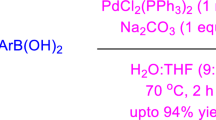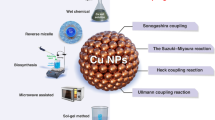Abstract
Catalytic efficiency of palladium ion substituted in TiO2, Ti0.97Pd0.03O1.97 is successfully exploited for the oxidative homocoupling of arylboronic acid and oxidative Heck coupling reactions between arylboronic acid and olefins. The reaction protocol provides direct approach to synthesize biphenyls and cinnamates from moderate to good yield with good functional group tolerance. As a result, 11 symmetrical biaryls and 14 cinnamates were synthesized from readily available arylboronic acids. Ti0.97Pd0.03O1.97 powder catalyst is synthesized by solution combustion method and characterized by powder X-ray diffraction. The C–C bond formation reactions were carried out by catalyst cartridge method using Ti0.97Pd0.03O1.97 catalyst coated cordierite monolith. Coating of the catalyst on a cordierite monolith enhanced the applicability of the catalyst and made handling and recycling of the catalyst very easy. Catalyst was recovered and recycled for eight times in both homocoupling and oxidative Heck coupling reactions. The turnover number for both the reactions found to be 443 and 424, respectively.
Graphic Abstract







Similar content being viewed by others
References
Miyaura N, Suzuki A (1995) Palladium-catalyzed cross-coupling reactions of organoboron compounds. Chem Rev 95(7):2457
Baudoin O, Cesario M, Guenard D, Gueritte F (2002) Application of the palladium-catalyzed borylation/Suzuki coupling (BSC) reaction to the synthesis of biologically active biaryl lactams. J Org Chem 67(4):1199
Wong KT, Hung TS, Lin Y, Wu CC, Lee GH, Peng SM, Chou CH, Su YO (2002) Suzuki coupling approach for the synthesis of phenylene–pyrimidine alternating oligomers for blue light-emitting material. Org Lett 4(4):513
Kotha S, Lahiri K, Kashinath D (2002) Recent applications of the Suzuki-Miyaura cross-coupling reaction in organic synthesis. Tetrahedron 58(48):9633
Nicolaou KC, Boddy CNC, Brase S, Winssinger N (1999) Chemistry, biology, and medicine of the glycopeptide antibiotics. Angew Chem Int Ed 38(15):2096
Horton DA, Bourne GT, Smythe ML (2003) The combinatorial synthesis of bicyclic privileged structures or privileged substructures. Chem Rev 103(3):893–930
Lloyd-Williams P, Giralt E (2001) Atropisomerism, biphenyls and the Suzuki coupling: peptide antibiotics. Chem Soc Rev 30(3):145–157
Dhital RN, Sakurai H (2014) Oxidative coupling of organoboron compounds Asian. J Org Chem 3(6):668–684
Salam N, Kundu SK, Roy AS, Mondal P, Ghosh K, Bhaumik A, Islam SM (2014) A ruthenium-grafted triazine functionalized mesoporous polymer: a highly efficient and multifunctional catalyst for transfer hydrogenation and the Suzuki-Miyaura cross-coupling reactions. Dalton Trans 43(19):7057–7068
Han FS (2013) Transition-metal-catalyzed Suzuki-Miyaura cross-coupling reactions: a remarkable advance from palladium to nickel catalysts. Chem Soc Rev 42(12):5270–5298
Shi W, Liu C, Lei A (2011) Transition-metal catalyzed oxidative cross-coupling reactions to form C-C bonds involving organometallic reagents as nucleophiles. Chem Soc Rev 40(5):2761–2776
Moreno-Manas M, Perez M, Pleixats R (1996) Palladium-catalyzed Suzuki-type self-coupling of arylboronic acids. A mechanistic study. J Org Chem 61(7):2346–2351
Prastaro A, Ceci P, Chiancone E, Boffi A, Fabrizi G, Cacchi S (2010) Homocoupling of arylboronic acids and potassium aryltrifluoroborates catalyzed by protein-stabilized palladium nanoparticles under air in water. Tetrahedron Lett 51(18):2550–2552
Tyagi D, Binnani C, Rai RK, Dwivedi AD, Gupta K, Li P-Z, Zhao Y, Singh SK (2016) Ruthenium-catalyzed oxidative homocoupling of arylboronic acids in water: ligand tuned reactivity and mechanistic study. Inorg Chem 55(12):6332–6343
Wong MS, Zhang XL (2001) Ligand promoted palladium-catalyzed homo-coupling of arylboronic acids. Tetrahedron Lett 42(24):4087–4089
Xu Z, Mao J, Zhang Y (2008) Pd(OAc)2-catalyzed room temperature homocoupling reaction of arylboronic acids under air without ligand. Catal Commun 9(1):97–100
Sable V, Maindan K, Kapdi AR, Shejwalkar PS, Hara K (2017) Active palladium colloids via palladacycle degradation as efficient catalysts for oxidative homocoupling and cross-coupling of aryl boronic acids. ACS Omega 2(1):204–217
Guo X, Deng G, Li C-J (2009) Ruthenium-catalyzed oxidative homo-coupling of 2-arylpyridines. Adv Synth Catal 351(13):2071–2074
Li B-J, Shi Z-J (2012) From C(sp2)–H to C(sp3)–H: studies on transition metal-catalyzed C–C oxidative formation. Chem Soc Rev 41(17):5588–5598
Shi Z, Zhang C, Tang C, Jiao N (2012) Recent advances in transition-metal catalyzed reactions using molecular oxygen as the oxidant. Chem Soc Rev 41(8):3381–3430
Reddy GM, Rao NSS, Satyanarayana P, Maheswaran H (2015) PhI(OCOCF3)2-mediated ruthenium catalyzed highly site-selective direct ortho-C–H monoarylation of 2-phenylpyridine and 1-phenyl-1H-pyrazole and their derivatives by arylboronic acids. RSC Adv 5(127):105347–105352
Martin R, Buchwald SL (2008) Palladium-catalyzed Suzuki-Miyaura cross coupling reactions employing dialkylbiaryl phosphine ligands. Acc Chem Res 41(11):1461
Johansson SCC, Kitching MO, Colacot TJ, Snieckus V (2012) Palladium-catalyzed cross-coupling: a historical contextual perspective to the 2010 nobel prize. Angew Chem Int Ed 51(21):5062
Cordovilla C, Bartolome C, Martinez-Ilarduya JM, Espinet P (2015) The Stille reaction, 38 years later. ACS Catal 5(5):3040
Haas D, Hammann JM, Greiner R, Knochel P (2016) Recent developments in negishi cross-coupling reactions. ACS Catal 6(3):1540
Heck RF (1979) Palladium-catalyzed reactions of organic halides with olefins. Acc Chem Res 12(4):146–151
Trzeciak AM, Ziołkowski JJ (2005) Structural and mechanistic studies of Pd-catalyzed CC bond formation: the case of carbonylation and Heck reaction. Coord Chem Rev 249(21–22):2308–2322
Whitcombe NJ, Hii KK, Gibson SE (2001) Advances in the Heck chemistry of aryl bromides and chlorides. Tetrahedron 57(35):7449–7476
Tsuji J (2004) Palladium reagents and catalysts. Wiley, New York
Negishi E (2002) Handbook of organopalladium chemistry for organic synthesis. Wiley, New York
Dieck HA, Heck RF (1975) A palladium-catalyzed conjugated diene synthesis from vinylic halides and olefinic compounds. J Org Chem 40(8):1083–1090
Beletskaya IP, Cheprakov AV (2000) The Heck reaction as a sharpening stone of palladium catalysis. Chem Rev 100(8):3009–3066
Dounay AB, Overman LE (2003) The asymmetric intramolecular Heck reaction in natural product total synthesis. Chem Rev 103(8):2945–2964
Roszak R, Trzeciak AM, Pernak J, Borucka N (2011) Effect of chiral ionic liquids on palladium-catalyzed Heck arylation of 2,3-dihydrofuran. Appl Catal A Gen 409:148–155
Mieczynska E, Gniewek A, Pryjomska-Ray I, Trzeciak AM, Grabowska H, Zawadzki M (2011) The Heck arylation of mono- and disubstituted olefins catalysed by palladium supported on alumina-based oxides. Appl Catal A Gen 393(1–2):195–205
Hirabayashi K, Nishihara Y, Mori A, Hiyama T (1998) A Novel C-C Bond forming reaction of aryl- and alkenylsilanols. A halogen-free Mizoroki-Heck type reaction. Tetrahedron Lett 39(43):7893–7896
Takaku K, Shinokubo H, Oshima K (1996) Intramolecular iodosilyletherization of alkenyisilanols with bis(2,4,6-trimethylpyridine)iodine(I) hexafluorophosphate. Tetrahedron Lett 37(37):6781–6784
Takaku K, Shinokubo H, Oshima K (1997) ʏ-Regioselective reaction of metaloxysilyi-substituted ailyllithium derived from allyldiphenylsilanol. Tetrahedron Lett 38(29):5189–5192
Matoba K, Motofusa S, Chan SC, Ohe K, Uemura S (1999) Palladium(II)-catalyzed phenylation of unsaturated compounds using phenylantimony chlorides under air. J Organomet Chem 574(1):3–10
Oda H, Morishita M, Fugami K, Sano H, Kosugi M (1996) A Novel Diarylation reaction of alkynes by using aryltributylstannane in the presence of palladium catalyst. Chem Lett 25(9):811–812
Fugami K, Hagiwara S, Oda H, Kosugi M (1998) Novel palladium-catalyzed diarylation and dialkenylation reactions of norbornene derivatives. Synlett 5:477–478
Hirabayashi K, Ando J, Nishihara Y, Mori A, Hiyama T (1999) A coupling reaction of aryltributyltin with olefins mediated by palladium(II) acetate. Synlett 1:99–101
Heck RF (1968) Arylation, methylation, and carboxyalkylation of olefins by group VIII metal derivatives. J Am Chem Soc 90(20):5518–5526
Heck RF (1969) The mechanism of arylation and carbomethoxylation of olefins with organopalladium compounds. J Am Chem Soc 91(24):6707–6714
Du XL, Suguro M, Hirabayashi K, Mori A, Nishikata T, Hagiwara N, Kawata K, Okeda T, Wang HF, Fugami K, Kosugi M (2001) Mizoroki−Heck type reaction of organoboron reagents with alkenes and alkynes A Pd(II)-catalyzed pathway with Cu(OAc)2 as an oxidant. Org Lett 3(21):3313–3316
Andappan MMS, Nilsson P, Larhed M (2003) Arylboronic acids as versatile coupling partners in fast microwave promoted oxidative Heck chemistry. Mol Div 7(2–4):97–106
Liu Y, Li D, Park C-M (2011) Stereoselective synthesis of highly substituted enamides by an oxidative Heck reaction. Angew Chem Int Ed 50(32):7333–7336
Inamoto K, Kawasaki J, Hiroya K, Kondo Y, Doi T (2012) Tandem-type Pd(II)-catalyzed oxidative Heck reaction/intramolecular C-H amidation sequence: a novel route to 4-aryl-2-quinolinones. Chem Commun 48(36):4332–4334
Penn L, Shpruhman A, Gelman D (2007) Enantio- and regioselective Heck-type reaction of arylboronic acids with 2,3-dihydrofuran. J Org Chem 72(10):3875–3879
Song E, Park J, Oh K, Jung HM, Lee S (2010) Ligand-free palladium-catalyzed Mizoroki-Heck-type reaction of arylboronic acids and alkenes using silver cation. Bull Korean Chem Soc 31(6):1789–1792
Su Y, Jiao N (2009) Control of chemo-, regio-, and stereoselectivities in ligand-free Pd-catalyzed oxidative Heck reactions of arylboronic acids or alkenylboronate with allyl esters. Org Lett 11(14):2980–2983
Jung YC, Mishra RK, Yoon CH, Jung KW (2003) Oxygen-promoted Pd(II) catalysis for the coupling of organoboron compounds and olefins. Org Lett 5(13):2231
Yoon CH, Yoo KS, Yi SW, Mishra RK, Jung KW (2004) Oxygen-promoted palladium(II) catalysis: facile C(sp2)−C(sp2) bond formation via cross-coupling of alkenylboronic compounds and olefins. Org Lett 6(22):4037
Silarska E, Trzeciak AM (2015) Oxygen-promoted coupling of arylboronic acids with olefins catalyzed by [CA]2[PdX4] complexes without a base. J Mol Cat A-Chem 408:1–11
Yoo KS, Yoon CH, Jung KW (2006) Oxidative palladium(II) catalysis: A highly efficient and chemoselective cross-coupling method for carbon-carbon bond formation under base-free and nitrogenous-ligand conditions. J Am Chem Soc 128(50):16384–16393
Sakaguchi S, Yoo KS, O’Neill J, Lee JH, Stewart T, Jung KW (2008) Chiral palladium(II) complexes possessing a tridentate N-heterocyclic carbene amidate alkoxide ligand: access to oxygen-bridging dimer structures. Angew Chem Int Ed 47(48):9326–9329
Yoo KS, Sakaguchi S, Oneill J, Giles R, Lee JH, Jung KW (2010) Asymmetric intermolecular boron Heck-type reactions via oxidative palladium(II) catalysis with chiral tridentate NHC-amidate-alkoxide ligands. J Org Chem 75(1):95–101
Mi X, Huang M, Guo H, Wu Y (2013) An efficient palladium(II) catalyst for oxidative Heck-type reaction under base-free conditions. Tetrahedron 69(25):5123–5128
Ruan J, Li X, Saidi O, Xiao J (2008) Oxygen and base-free oxidative Heck reactions of arylboronic acids with olefins. J Am Chem Soc 130(8):2424–2425
Andappan MMS, Nilsson P, Von Schenck H, Larhed M (2004) Dioxygen-promoted regioselective oxidative Heck arylations of electron-rich olefins with arylboronic acids. J Org Chem 69(16):5212–5218
Nordqvist A, Bjorkelid M, Andaloussi A, Jansson M, Mowbray SL, Karlen A, Larhed M (2011) Synthesis of functionalized cinnamaldehyde derivatives by an oxidative Heck reaction and their use as starting materials for preparation of mycobacterium tuberculosis 1-deoxy-d-xylulose 5-phosphate reductoisomerase inhibitors. J Org Chem 76(21):8986–8998
Zou G, Zhu J, Tang J (2003) Cross-coupling of arylboronic acids with terminal alkynes in air. Tetrahedron Lett 44(48):8709–8711
Hegde MS, Madras G, Patil KC (2009) Noble metal ionic catalysts. Acc Chem Res 42(6):04–712
Hegde MS, Nagaveni K, Roy S (2005) Synthesis, structure and photocatalytic activity of nano TiO2 and nano Ti1−xMxO2−δ (M = Cu, Fe, Pt, Pd, V, W, Ce, Zr) Pramana. J Phys 65(4):641
Mukri BD, Dutta G, Waghmare UV, Hegde MS (2012) Activation of lattice oxygen of TiO2 by Pd2+ ion: correlation of low-temperature CO and hydrocarbon oxidation with structure of Ti1−xPdxO2−x (x = 001–003). Chem Mater 24(23):4491–4502
Sharma S, Hegde MS (2009) Ti0.99Pd0.01O2-δ: a new Pt-free catalyst for high rates of H2+O2 recombination with high CO tolerant capacity. ChemPhysChem 10(4):637–640
Mukri BD, Hegde MS (2017) High rates of catalytic hydrogen combustion with air over Ti0.97Pd0.03O2−δ coated cordierite monolith. J Chem Sci 129(9):1363
Bhat SK, Prasad JD, Hegde MS (2019) Recyclable Pd ionic catalyst coated on cordierite monolith for high TOF Heck coupling reaction. J Chem Sci 131(3):20
Molnár A, Papp A (2017) Catalyst recycling: a survey of recent progress and current status. Coord Chem Rev 349:1–65
Acknowledgements
Authors thank P. Bera for recording the XPS data.
Author information
Authors and Affiliations
Corresponding authors
Additional information
Publisher's Note
Springer Nature remains neutral with regard to jurisdictional claims in published maps and institutional affiliations.
Electronic supplementary material
Below is the link to the electronic supplementary material.
Rights and permissions
About this article
Cite this article
Bhat, S.K., Prasanna, Dasappa, J.P. et al. Palladium Ion Catalysed Oxidative C–C Bond Formation Reactions in Arylboronic Acid: Application of Cordierite Monolith Coated Catalyst. Catal Lett 150, 2911–2927 (2020). https://doi.org/10.1007/s10562-020-03194-z
Received:
Accepted:
Published:
Issue Date:
DOI: https://doi.org/10.1007/s10562-020-03194-z




